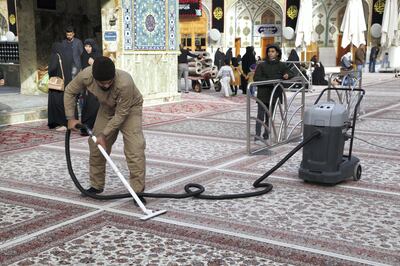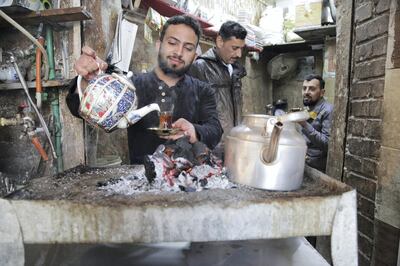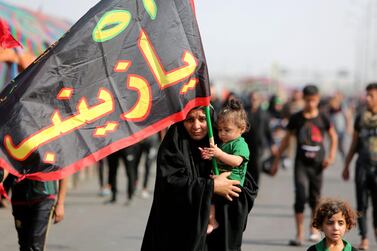In the courtyard of Imam Ali’s shrine, a pair of red-haired Lebanese toddlers delight in rolling around on its Persian carpets.
Their father, a cleric from south Lebanon, calmly watches over them. A few paces away, shrine staff vacuum the already spotless carpets.
The luxurious rugs, in cream and yellow swirls, are from the Iranian city of Isfahan.
They are not the only signs of Iran in Najaf, a sprawling city in dusty southern Iraq.
Signs at the shrine cafeteria, which serves thousands of free meals to pilgrims every day, are in Farsi, Arabic and English.
Traditionally, about 85 per cent of foreign visitors to Najaf are Iranian.
Others, such as the cleric and his children, are from Lebanon, as well as Bahrain, India and Pakistan. But the city has been hit by Iran’s economic woes, which have worsened since the reimposition of US sanctions on Tehran last year.
Last month, Iran’s Cultural Heritage, Handicraft and Tourism Organisation said the number of people travelling abroad fell by 30 per cent in the first nine months of 2018, to 5.9 million.
Najafis employed in the city’s religious tourism trade are feeling the effects of Iranians’ tightened purse strings.
Salim Al Fadul owns the Alnahrain Hotel, a 10-minute walk from the Imam Ali shrine.
“Compared with last year, the difference is obvious,” he said, referring to the drop in tourists. “There are fewer people, and those who do come are spending less.
"My brother had two hotels too but he has closed one of them.”
Mr Al Fadul is one of several businessmen calling on authorities to make it easier for all types of tourists to visit Iraq, including Najaf, to compensate for Iranian cutbacks.
“There are long queues at the airport,” he said. “If I was a foreigner I would be put off and not come.
“There needs to be training for people to learn how to deal with tourists, for taxi drivers, for example, so they don’t rip off visitors.”
Saeb Abu Ghanem, director of Najaf’s hotelier association, said 200 of the city’s hotels and restaurants had closed since the end of 2014, particularly those serving Iranian cuisine.
Mr Abu Ghanem urged Iraqi authorities to remove visa charges and make entry documents easier to obtain for foreign travellers.
With some exceptions at peak pilgrimage periods, Iranian tourists pay a $40 (Dh147) for a visa.

“Other countries have e-visa schemes – everyone is doing this now,” Mr Abu Ghanem said from his office. “Terrorists don’t come in through the airport.”
He opposed Iraqis offering free accommodation and transport during the annual Shiite pilgrimage of Arbaeen.
Although it is customary for locals to host pilgrims during the event, Mr Abu Ghanem feared Iranian visitors would soon flock to Najaf only at Arbaeen to minimise their costs.
“In Arbaeen everything is free and it destroys the economy,” he said. “There is free food and drink and it’s competition for the private sector.”
The Iranian rial has lost value against the Iraqi dinar and last year fell to a record low on unofficial markets – 138,000 rials to the dollar.
The World Bank expects Iran’s economy to go into recession until 2020 and experience stagflation, characterised by rising prices, low growth and high unemployment.
Mohammad Hharanli, a fire station manager from the Iranian city of Qom, estimates a fivefold increase in prices since his last visit three years ago.
“But it is worth the trip,” Mr Hharanli said. "This is a holy place for us."
His brother Reza Arysha flew from Australia to join his family in Najaf, paying more than $1,000 for flights.
“I could spend so much less than this price in a country like Thailand,” Mr Arysha said. “I’d just need $500 for that. But I prefer coming here.”
Shrine authorities deny there is a problem with fewer pilgrims spending less time and money in Najaf.
“We are not a tour company,” said Faeq Al Shammary, head of the shrine management council, when asked how the city might attract other tourists.
Najaf municipality was unable to provide visitor numbers.
But locals say it is not all down to the drop in Iranian tourists and stringent US sanctions. Some believe that government negligence and Iraq’s economic woes are also damaging the city.
Last summer, protests over corruption, paltry job opportunities and poor services in southern Iraq spread to Najaf, where demonstrators stormed the airport and attacked politicians’ offices.
Although ISIS did not reach the country’s south, Iraq’s costly campaigns against the militant group have exacerbated long-standing economic woes.
Former prime minister Haider Al Abadi estimated the cost at $100 billion (Dh367.6bn), while Iraqi officials said $88bn would be needed to rebuild destroyed homes and infrastructure.

Mr Al Fadul bemoaned general neglect in the city.
“Look at the streets here – it is dirty,” he said. “No one cares. People have suffered a lot and that’s one part of the explanation.
“But there is a culture of not promoting hard work or honesty, either.”
Opportunities to attract pilgrims from countries other than Iran may increase as Iraq’s security situation stabilises.
On streets spiralling outwards from the shrine, vats of hot tea provide relief from Najaf’s dry, chilly desert air.
A green scarf draped around his shoulders, money changer Mounir Diaa watches over his counter, which is lined with Iranian banknotes.
“Our interest is not only religious pilgrims from Iran but people from the Gulf and other neighbouring countries,” Mr Diaa says, waving piles of orange Indian and Pakistani bills.
Mohamed Raza Jaffer, owner of UK pilgrimage operator Alavi Tours, says there has been a 30 per cent rise in bookings in the past 12 months and his company now serves about 220 clients a year.
“Demand for trips to Iraq is increasing because ISIS and other terrorist groups are not there any more,” Mr Jaffer told The National.
“A few ask about security but they don’t cancel the trip because they are mentally prepared to go, since there is no war.”
Najaf’s religious tourism trade is being buffeted by geopolitics.
But those who do make it here, from Lebanese toddlers to Mr Jaffer’s clients, will be among the pilgrims who gather calmly in the shrine courtyard, beneath its embellished clock tower and on top of its Isfahani rugs.






